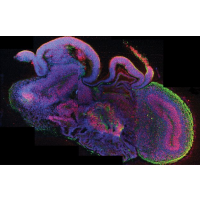On the Cutting Edge: Scientists Grow Mini Brains and Transfer Thoughts between Brains
 Cerebral organoid (photo: Madeline A. Lancaster)
Cerebral organoid (photo: Madeline A. Lancaster)
Scientists in the United States and Europe this week revealed two very different advances in brain research, demonstrating that it is possible to grow brains in a lab and to transfer thoughts from one person to another.
At the Institute of Molecular Biotechnology in Vienna, Austria, a team of researchers announced that they grew mini human brains in a lab for more than a year. The “cerebral organoids” were created using stem cells bathed in nutrients and spun in a specialized chamber.
The cells not only grew, but also organized themselves into separate regions of the brain, such as the cerebral cortex, the retina and the hippocampus.
The project’s leader, Jürgen Knoblich, said the organoids are not “brains-in-a-jar.”
“We’re talking about the very first steps of embryonic brain development, like in the first nine weeks of pregnancy,” Knoblich told The Scientist. “They’re nowhere near an adult human brain, and they don’t form anything that resembles a neuronal network.”
The researchers said the purpose of their work is to improve medical science’s understanding of neurological disorders, such as schizophrenia or autism, which typically manifest in adults, but may begin during the brain’s early development.
In the U.S. at the University of Washington, Professor Rajesh Rao said he had managed to transfer some simple thoughts to another researcher using electrodes and a computer.
Using what was described as the world’s first noninvasive human brain interface, Rao was hooked up to an electroencephalograph (EEG), which measures electrical activity in the brain. The device relayed a thought—moving his finger to press the space bar on a keyboard to play a video game—to a computer that sent the information over the Internet to Rao’s associate, Andrea Stocco, who like Rao wore a blue swimming cap with a magnetic stimulation coil affixed over his left motor cortex. The result: When Rao thought about moving his right hand, Stocco’s moved.
Rao hopes next to move more than one finger at a time towards eventually typing out a word on a keyboard. His intention is that the work will lead to sophisticated remote communications, such as a doctor relaying medical assistance to someone at the scene of a car accident.
-Noel Brinkerhoff
To Learn More:
Lab-Grown Model Brains (by Ed Young, The Scientist)
Miniature 'Human Brain' Grown in Lab (by James Gallagher, BBC News)
How One Scientist Hacked Another Scientist's Brain (by Elizabeth Barber, Christian Science Monitor)
Direct Brain-to-Brain Communication in Humans: A Pilot Study (University of Washington)
- Top Stories
- Unusual News
- Where is the Money Going?
- Controversies
- U.S. and the World
- Appointments and Resignations
- Latest News
- Musk and Trump Fire Members of Congress
- Trump Calls for Violent Street Demonstrations Against Himself
- Trump Changes Name of Republican Party
- The 2024 Election By the Numbers
- Bashar al-Assad—The Fall of a Rabid AntiSemite






Comments